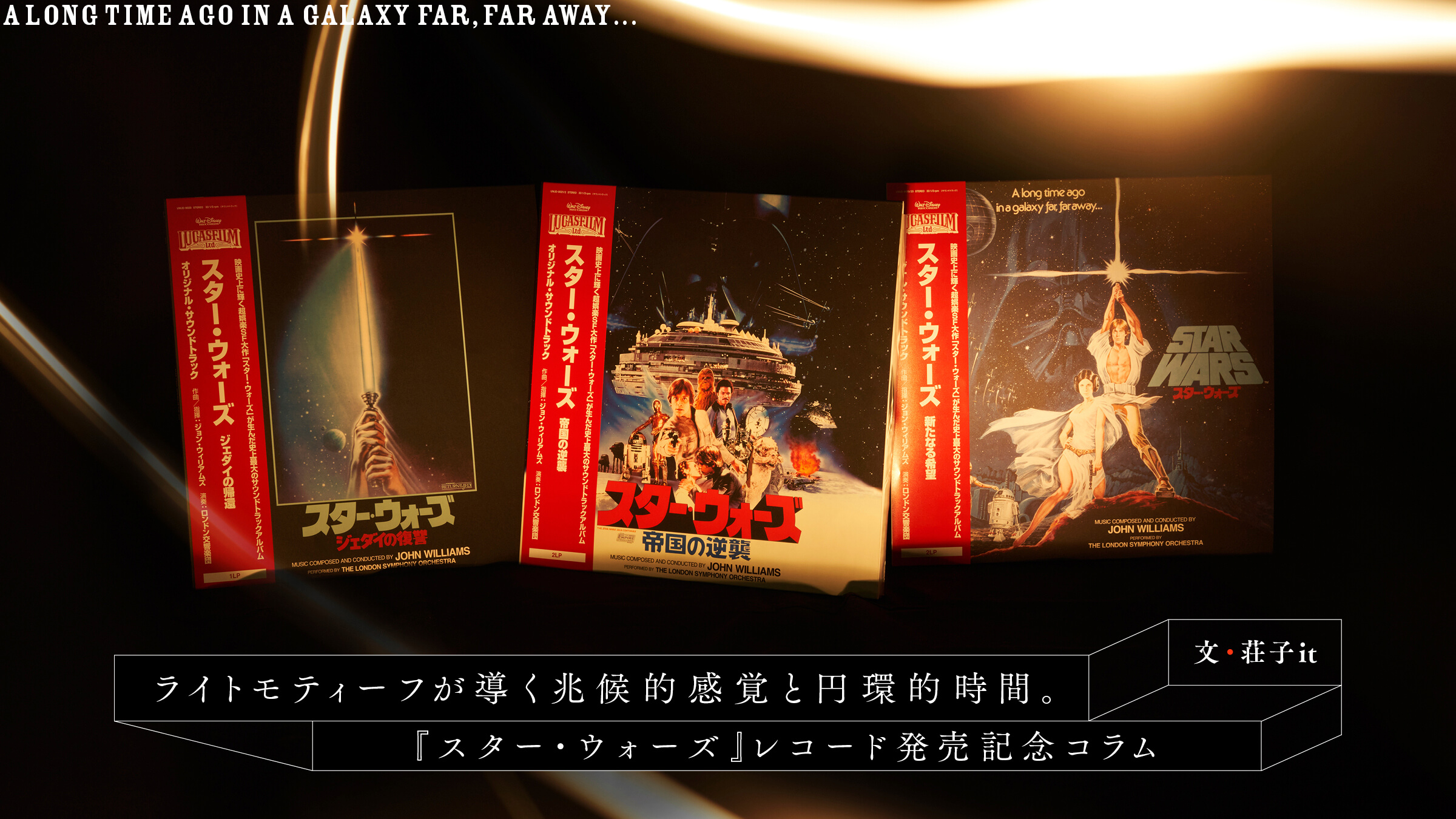PROFILE

Born in 1993 in Tokyo, Japan, he formed "Dos Monos" in 2015 with his middle school friends TaiTan and Immortal in 2015, signed a contract with the American label Deathbomb Arc in 2018, released his first album "Dos City" in March 2019, and in July 2020, released " Dos Siki" in July 2020, and "Dos Siki 2nd Season" on the same day in 2021. In addition to his work as "Dos Monos," he also produces and provides music to other artists.
Instagram:@so_shi_it
Significance and circular time guided by light motifs in "Star Wars.
Text, Zhuangzi it.
What characterizes John Williams' dramatic accompaniment for "Star Wars" is the active use of "leitmotiv" (=Leitmotiv). Leitmotiv is a musical term originally used in the 19th century in the study and criticism of Richard Wagner's operas and Franz Liszt's symphonic poems, and is translated as "indicative motive.
Although there is not enough space to go into the specifics of how the term "light motif" came about and how it is used by different speakers, it is now commonly used to refer to a single characteristic melody or fragment (called a "theme" or "motive" in musical terms) that is repeated in a piece that runs parallel to a narrative, such as an opera or film music piece. theme" or "motive") is in common usage.
The same light motif appears repeatedly in the work to evoke in the audience a particular character, group, thing, or state of mind, or to create an impression of the mood of a scene.
In terms of specific songs, the melodies presented in "Star Wars Theme "Main Title (The Story Continues)" and "Darth Vader's March "The Imperial March (Darth Vader's Theme" are played many times throughout the film (there is also "Princess Leia's Theme" and "Yoda's Theme," but these two are probably the most prominent and frequent).
Each of them represents the Jedi, Rebels and (early) Republican forces to which the protagonists of each film belong in the "Star Wars Theme" and the dark side of the Sith, Imperial forces and Darth Vader in the "Darth Vader's March" respectively. The music is very contrasting: the former, with its major key and light rhythm, is romantic and heroic, while the latter, with its minor key and heavy rhythm, is dark and recognizable as a villain. Even if one were to compare the two tracks with someone who knows nothing about the "Star Wars" story, this impression would not change much.
While the light and dark are very clearly depicted in this way, anyone familiar with the overall story of the "Star Wars" series knows that they are also transitory. This is symbolized by the character of Anakin Skywalker, who started out as a slave, trained and fought as a Jedi warrior, and eventually, due to unfortunate circumstances, fell to the dark side of the Force and became Darth Vader, the Dark Lord of the Sith, standing by the Imperial Army. This is symbolically indicated by the fact that he became the Dark Lord of the Sith, Darth Vader, and came to stand on the side of the Imperial Army.

From "Star Wars: Return of the Jedi" © 2022 Lucasfilm Ltd.
Available on Disney Plus
In addition to this worldview in which good and evil are two sides of the same coin, like yin and yang, a distinctive time structure also characterizes "Star Wars.
The "Star Wars" film series, in order of release, begins with Episodes 4 through 6, followed by the prequels 1 through 3, and finally 7 through 9.
However, I myself, born in 1993, watched "Star Wars Episode I: The Phantom Menace," released in 1999, in real time as a young boy, which was my first "Star Wars" viewing. As the title suggests, I had no doubt that this was the first in the series, and I was immersed in the adventures of Anakin Skywalker and the story of his becoming a Jedi. Some time later, I finally learned about the order of release and that it was the story of Anakin's fall to the dark side and his battle with his own son, Luke Skywalker.
If we follow the order in which the filmmakers originally envisioned, the protagonist to whom we are emotionally invested is Luke Skywalker in Episodes 4-6, and Episodes 1-3 are a prequel to Anakin Skywalker, his arch-nemesis and real father, so the usual way of looking at the story is that Darth Vader, the evil one, had a good time. Therefore, the normal way of looking at the story is that Darth Vader, who is the authority of evil, also had a good time.

From "Star Wars: A New Hope" © 2022 Lucasfilm Ltd.
Available on Disney Plus
However, if you watch the movie from Episode 1, as I did, you will see it in the opposite way. Anakin, who is supposed to be the person to whom we are emotionally attached, sometimes hints at the possibility that he may fall to the dark side, and we sense this implicitly.
What this means is that, depending on the perspective one takes, one's perception of the same scene can be either a "recollection of the past" or a "premonition of the future".
This, in fact, goes hand in hand with the musical technique of the light motif itself.

From "Star Wars: The Empire Strikes Back" © 2022 Lucasfilm Ltd.
Available on Disney Plus
At the beginning of this article, I mentioned that the leitmotif was popularized by Wagner's discourse on operatic music, but Wagner himself does not use this as his terminology. However, as a theorist, Wagner actively discussed his own technique, and in his seminal work "Opera and Drama," there are passages in which he discusses a similar technique, although he does not use the term leitmotif himself.
As noted there, the technique of "recollecting" something specific by having the same motif reappear had itself existed long before Wagner, such as in the operas of Wolfgang Amadeus Mozart, but Wagner himself claimed to have utilized it in a more developed way. He may have wanted the power of operatic music to convey something that was not merely narrative (i.e., dramaturgical) "recollection," but something unknown to the audience, i.e., to "foreshadow" something in a symptomatic way.
This worldview in which the future is already indicated is also common to the story of King Oedipus, the archetype of the father-son conflict as in "Star Wars". Oedipus , too, was told of his end by a prophet from the beginning of the story.
The circular sense of time, in which everything past and future is folded into the present, rather than a linearly evolving sense of time, is not of Western modernity, but of ancient Greece and the East. For Wagner, this was a challenge to the usual zeitgeist of his time. This is a move that might be taken as a conservative reaction, and indeed, "The Ring of the Nibelung," with its mastery of light-motif-like techniques, is of a different character from the straightforward progressiveness of "Tristan und Isolde," which anticipates the later 20th century music of broken tonality.

From "Star Wars: The Empire Strikes Back" © 2022 Lucasfilm Ltd.
Available on Disney Plus
The introduction of John Williams-like light-motif orchestrations into Hollywood film music was also pioneered by Erich Wolfgang Korngold in the 1930s. Although his style, which shares the same name with Mozart and is often referred to as the second coming of Mozart, was a major advance in film music, it eventually became outdated as time went on, with simpler and more concise dramatic accompaniment becoming the norm in Hollywood movies from the 1960s onward.
Against this backdrop, John Williams' theatrical accompaniment for "Star Wars," which began in 1977, was probably not the most advanced of its time (as the "space opera" moniker suggests), but it strongly inspired many people. And now, in 2021, if you play the "Star Wars" soundtrack on vinyl again and listen to the repetitive light motifs, you can sense, as if guided by the Force, something absolutely known, yet unknown, in a circular time of regression of the same thing. . you can sense it.
Analog records are now on sale!

Star Wars: A New Hope Original Soundtrack
¥5,940

Star Wars: The Empire Strikes Back Original Soundtrack
¥5,940

Star Wars: Return of the Jedi Original Soundtrack
¥5,940
Purchase isthis way (direction close to the speaker or towards the speaker)Please start at









